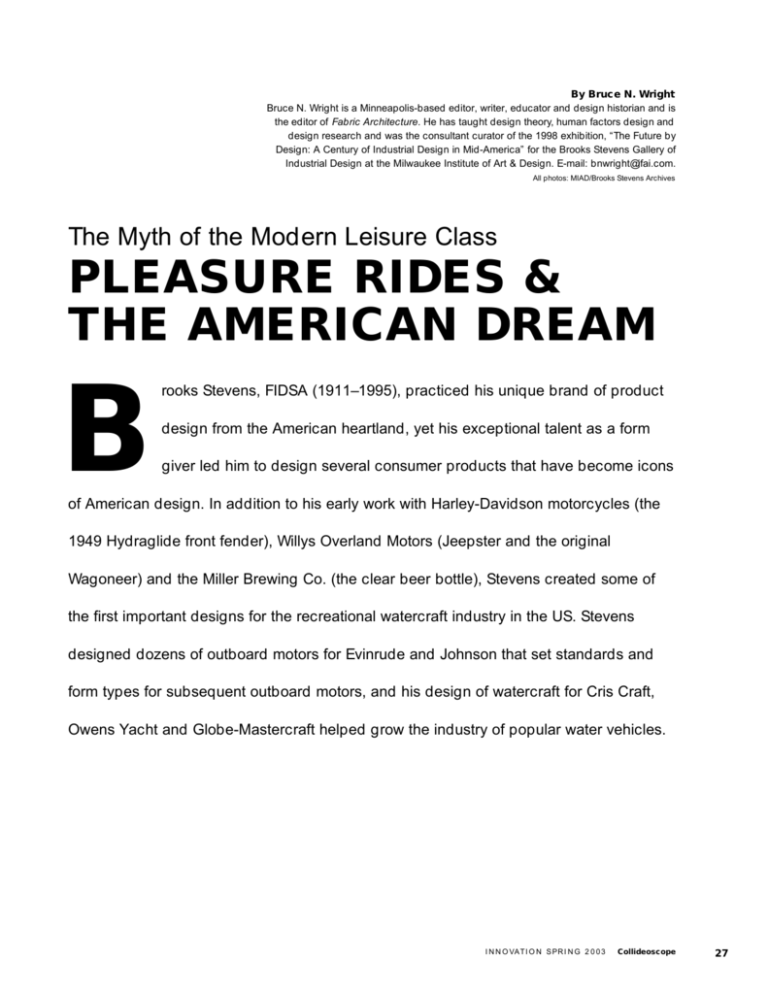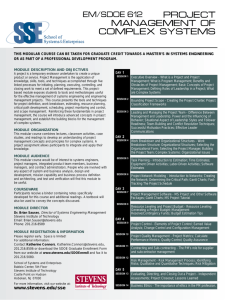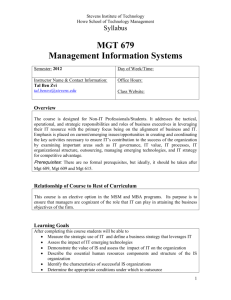PLEASURE RIDES & THE AMERICAN DREAM Brooks
advertisement

By Bruce N. Wright Bruce N. Wright is a Minneapolis-based editor, writer, educator and design historian and is the editor of Fabric Architecture. He has taught design theory, human factors design and design research and was the consultant curator of the 1998 exhibition, “The Future by Design: A Century of Industrial Design in Mid-America” for the Brooks Stevens Gallery of Industrial Design at the Milwaukee Institute of Art & Design. E-mail: bnwright@ifai.com. All photos: MIAD/Brooks Stevens Archives The Myth of the Modern Leisure Class PLEASURE RIDES & THE AMERICAN DREAM B rooks Stevens, FIDSA (1911–1995), practiced his unique brand of product design from the American heartland, yet his exceptional talent as a form giver led him to design several consumer products that have become icons of American design. In addition to his early work with Harley-Davidson motorcycles (the 1949 Hydraglide front fender), Willys Overland Motors (Jeepster and the original Wagoneer) and the Miller Brewing Co. (the clear beer bottle), Stevens created some of the first important designs for the recreational watercraft industry in the US. Stevens designed dozens of outboard motors for Evinrude and Johnson that set standards and form types for subsequent outboard motors, and his design of watercraft for Cris Craft, Owens Yacht and Globe-Mastercraft helped grow the industry of popular water vehicles. I N N O VAT I O N S P R I N G 2 0 0 3 Collideoscope 27 A concept sketch for the shroud of an Evinrude outboard motor, circa 1959, showing strong influences of automotive styling. ■ Stevens’ “Fore-ward Look” styling for the 1959 Evinrude line showing the 5.5, 10, and 18 h.p. and the V-450 “Starflite” motors. This was Evinrude's 50th anniversary Jubilee line and the first year of the introduction of fiberglass shrouds. Stevens’ association with the marine industry dates from 1935, a year after he opened his design office in Milwaukee, when he began to introduce styling to outboard motors made by the Milwaukee-based Outboard Marine Corp. (OMC), makers of Evinrude and Johnson motors. (OMC has since been acquired by Bombardier.) Although the first fully enclosed outboard motor was developed by Evinrude a year before Stevens’ involvement, Stevens worked as a designer on the motor encasement, or shroud. He introduced the idea of streamlining (all the rage in the 1930s) to the exterior of the shroud and cleaned up some details of the controls and fittings. This helped accomplish several things: It improved noise control, vastly improved the outboard’s visual appeal, established the familial identity of a line of different sized motors and introduced the concept of yearly model changes. It also helped OMC establish its dominance in the burgeoning outboard market. Stevens’ designs for Evinrude and Johnson also brought him to the attention of the marine industry, and commissions for aquatic craft followed. These continued apace until World War II, when most non-essential US production was curtailed. But following the war, with his 28 Collideoscope I N N O V AT I O N S P R I N G 2 0 0 3 longstanding relationship with OMC firmly established, Stevens was well positioned to take advantage of consumers’ pent-up demand for recreational watercraft. According to design historian Arthur J. Pulos, FIDSA, the late 1940s and early ’50s saw a great surge in the popularity of powerboats, particularly outboards. In 1955, Johnson and Evinrude introduced the first electric starter on outboard motors. This had an immediate impact on the outboard industry and helped spur the growth of the pleasure-craft industr y. With electric-start outboards, more women were able to operate their own boats. Reliable remote steering, starting, shifting and speed controls made a boat as easy to operate as an automobile. This helped boost sales of larger horse-powered motors, and was accompanied by an increase in the size of the average boat. Bigger boats meant faster rides—and higher prices and greater profits. Marketing boats and motors directly to women also increased sales. More outboard motors were made and sold in the 1950s than in all the decades that had come before. Stevens’s new ideas and sophisticated styling heightened the outboard boom. Two futuristic proposals for outboard motors based on predictions of advanced technology. The Water Jet used twin jet-powered water pumps (similar to today's personal watercraft power units). The Turbojet used port and starboard jet pods exhausting into the atmosphere for propulsion. Underwater ailerons provided steering. Outboard Motors of the Future Brooks Stevens Associates’ marine designs for the mid1950s mimicked the automotive industry’s design of dream cars. The design firm proposed futuristic boats and motors to explore concepts and test public response. Stevens was particularly adept at this bit of showmanship and is credited with coining the phrase “planned obsolescence.” Although this term later took on negative connotations, in the post-war years it fit perfectly with American advertising’s efforts to stimulate demand for products. According to Stevens, the term referred to “the natural desire [on the part of consumers] to own something a little newer, a little better, a little sooner than is necessar y.” In a series of mid- to late-1950s boat shows, Stevens and his design office produced several concept designs—called Outboard Motors of the Future— that explored fantastic possibilities for marine equipment. Influenced by the allure of jet-engine airplanes and the burgeoning space industr y, Stevens speculated on turbo-jet outboard motors and a thing he called “aquajets” (high-powered water pumps) in what may be a prophetic prediction of today’s personal watercraft technology. In his “designer’s notes” for the 1956 New York Boat Show, Stevens states, “These designs are not for the moment practical or fully developed concepts. The industrial designer can be allowed a measure of ‘dream latitude’ in reaching into the future for a general design I N N O VAT I O N S P R I N G 2 0 0 3 Monterey Moments 29 Brooks Stevens designed the Fisherman concept boat for a 1957 New York Boat Show debut. Although it attracted much media attention, the Fisherman never went into production and was difficult to control in the water. which must be considered from both the functional and the aesthetic standpoint.” He described three rather extreme concepts for the Evinrude “X” Outboard Motor of Tomorrow that would fit right in with a Star Wars or Star Trek movie. The designs were published in a special section of Sports Illustrated in 1956. The following year at the New York boat show, Stevens introduced the Evinrude “Fisherman,” a flying saucer of a boat that seated eight people, ran on two outboards housed under clear plastic bubbles and had 30 Collideoscope I N N O VAT I O N S P R I N G 2 0 0 3 a central circular seating area with a mast that opened as a shade umbrella. The steering console looked like a spaceship’s command center, with a central radar-like screen (intended as an early form of fish finder) and an impressive phalanx of dials and controls. The design was a sensation at the New York boat show, as well as at subsequent boat shows across the country. The Fisherman also was featured on network TV and in national magazines. The design was selected for exhibition at the 1958 World’s Fair in Brussels. One-Off Designs with Advanced Styling The notion of “advanced styling” and one-off prophetic boat designs is a concept developed over decades by the automobile industry, an arena not unfamiliar to Stevens. The language used by OMC and Stevens to promote these futuristic designs also borrowed heavily from the auto industry. The 1950s designs—Stevens called them “transportation on the water”—appropriated aesthetics from hydroplanes, sports cars and jet airplanes. Evinrude even introduced a “station wagon of the sea” concept called the Famille, designed by Brooks Stevens Associates for the 1958 boat show. While many of these designs look dated 50 years later, Stevens was intuitively correct about nearly all of his design choices for the marine industry. An outboard motor or watercraft is not a static product but one that demands that its appearance suggest movement. While not all of his designs were commercially successful, Stevens met the challenge of designing beautiful watercraft beautifully. References Brooks Stevens Associates, “Designer’s Notes, New York Boat Show 1957: Evinrude Fisherman” (Milwaukee, WI: Brooks Stevens Archives at the Milwaukee Institute of Art & Design, n.d). Brooks Stevens Associates, “Designer’s Notes, Outboard Motor of the Future” (Milwaukee, WI: Brooks Stevens Archives at the Milwaukee Institute of Art & Design, March 1, 1956). Brooks Stevens Associates office brochure (1940s). Bunch, Bryan, and Alexander Hellemans, The Timetables of Technology (New York: Touchstone/Simon & Schuster, 1993). Pulos, Arthur J., The American Design Adventure (Cambridge, MA: MIT Press, 1988). Webb, W. J., with Robert W. Carrick, The Pictorial History of Outboard Motors (New York: Renaissance Editions, 1967). The 1956 Evinrude Lark In the mid-1950s Outboard Marine Corp. (OMC), manufacturers of the Johnson and Evinrude outboard motors, premiered a series of concept motors and watercraft at annual boat shows. Taking their cue from the auto industry's concept cars of the same period, OMC pushed the boundaries of the marine marketplace by offering fantastic and imaginative designs for boats and outboards. The 1956 Cadillac Sea Lark boat with the Evinrude Lark outboard was just such a landmark design. Custom designed by Brooks Stevens Associates, the Lark combination featured bucket seats, an aeronautical looking “tear drop” windshield and rocket-like tail fins that concealed retractable ski tow lines. The tips of the fins carried cylindrical taillights very much à-la-mode for late 1950s automotive styling, which borrowed heavily from jet airplane imagery. The outboard had chromed plastic trim angled to imply motion and speed. Textured grills on the tail fins, chrome plastic trim in strategic locations and instrument-like dials and controls evoked images of precision scientific equipment and streamlined space hardware. OMC's goal with these “dream boats” was to make boating as popular and convenient as driving an automobile through both marketing language and visual styling. Brooks Stevens, who developed his design practice and reputation in his extensive work for the automotive industry, was a perfect candidate to accomplish these goals. Over time, Stevens applied his styling skills to the trim, graphics and coloring of entire fleets of marine outboards for Evinrude, Johnson, Gale, Buccaneer, Sea Bee, Hiawatha, Royal and Fleetwing labels. I N N O V AT I O N S P R I N G 2 0 0 3 Collideoscope 31





